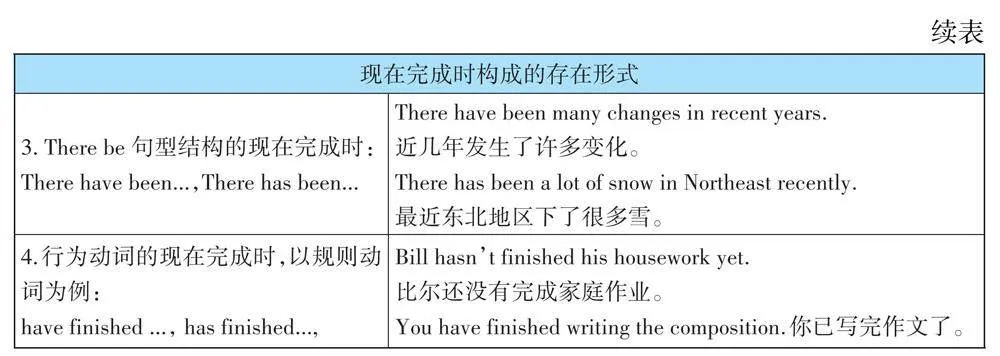现在完成时用法解析(一)
2024-08-26颜为


请先练习一下下面语篇填空题。
阅读下面的材料并填空。有的答案要填入适当的单词,有的答案要用括号内单词的正确形式,但每个答案不多于3个单词。
My hometown is a small town. It is in the southern part 1 Shandong Province. I left my hometown to work in Singapore 15 years ago. But I 2 (not be) back home for almost ten years.
Last month I came back to my hometown with my family. What I saw 3 (great)surprised me. Great changes 4 (take) place in the past ten years. The environment is getting 5 (beautiful) than before. The streets are wider and cleaner. There are trees and flowers everywhere. In the past,people used " 6 (travel) by bike. Now they take buses or drive cars. I’m sure transportation 7 (be) better in the future.
When I got home,my parent 8 (wait) for me at home. Then they told me a lot of the 9 (change) in my hometown. I can’t imagine 10 my hometown will be like in another ten years’ time.
Keys: "1. of 2. have not been 3. greatly 4. have taken 5. more beautiful "6. to travel 7. will be 8. were waiting 9. changes 10. what
做完上面的语篇填空题,同学们可以发现,题中空白处有两处运用到现在完成时时态。现在完成时态是初中英语学习的重点和难点,下面就现在完成时的用法做一总结。
一、现在完成时构成的存在形式
现在完成时由“have / has+过去分词”构成。其中have / has 为助动词。助动词have只能用于主语是第一人称、第二人称或第三人称复数,而助动词has用于主语是第三人称单数。
二、现在完成时用法
现在完成时主要有两种用法,一种是已完成用法,也叫影响性用法;另一种是未完成用法,也叫持续性用法。
1. 已完成用法(影响性用法):该用法的现在完成时表示一个过去发生的动作在过去已经完成,并且这个过去发生并完成的动作对现在有影响或结果,同时说话强调的或感兴趣的就是这个影响或结果。
She has left. 她离开了。(对现在的影响或结果:她现在不在这儿。)
Has she found her car key?
她找到她的车钥匙了吗?(对现在的影响或结果:她能开她的车了吗?)
I have finished my work. 我的工作做完了。(对现在的影响或结果:现在我没事了。)
He has eaten nothing today.
他今天什么也没吃。(对现在的影响或结果:他现在一定很饿。)
已完成用法特点:
(1)现在完成时已完成用法表示目前结果,其谓语动词常为短暂性(终止性)动词。如:come, arrive, reach, go, leave, break, hear, see, drop, meet, start, begin, get, die, buy, finish, open, close, join, lose, throw, fall, jump, knock, find, kill, put, give, pay, cut, stop等。
(2)已完成用法常与表示包括“现在”在内的或不确定的时间状语连用。
包括现在时间在内的时间状语有:
this morning afternoon, evening, week, month, year, today, now, just...
They have caught a lot of fish today.他们今天抓了很多鱼。
Father has just come back from Beijing.父亲刚从北京回来。
表示不确定的过去时间状语有:
already, yet, recently, lately, before...
I haven’t prepared for the mid⁃term exam yet.我还没有准备期中考试。
She has read a few English stories recently. 最近她看了几个英语故事。
(3)已完成用法常与表示频度的时间状语连用。
rarely, often, ever, never, once, twice, several, times, sometimes...
Have you ever read in the news in the newspaper? 你读过报纸上的新闻吗?
—Treasure Island is exciting. ——《金银岛》很刺激。
—I agree with you. I have read it twice.——我同意你的观点。我已经看了两次了。
2. 未完成用法(持续性用法):它表示动作或状态从过去某时开始,延续到现在可能刚刚完成(结束)或继续下去,这种用法表示长久的结果,其谓语动词常用延续性的动词。如:learn, study, work, keep, wait, read, live, sleep, watch, run, listen, talk, look, smile, speak, walk, stand, sit, blow, lie等。
Mr. Smith "has learned Chinese for two years. He’s much better at it now.
史密斯先生已经学习汉语两年了。他现在说得好多了。
How long have you lived here? 你在这里住了多久了?
I’ve known her for a long time. 我认识她很长时间了。
未完成用法特点:未完成用法常与表示持续的一段时间状语连用。
(1)表示现在时间在内的时间状语
till (up to) now, so far, in the past(last)years, these a few years, all day,all this while, these days, ever since then...
Great Changes have taken place in China in the past few years.
在过去的几年里,中国发生了巨大的变化。
He has posted two letters to his uncle these three months.
这3个月来他已经给他叔叔寄了两封信。
(2)由since引导的时间状语
它表示的是时间点,即“一段时间的起点”,since既可以作介词又可作连接词连接时间状语。
She has studied English by herself since last spring.
自去年春天以来,她一直自学英语。
We have known each other since we were child.我们从小就认识了。
(3)由for引导的时间状语
介词for后常接表示“一段时间”的名词,组成介词短语。
We have stayed at the hotel for three days.我们在这家旅馆已经住了3天了。
注:除以上用法外,现在完成时还可表示过去的重复动作甚至将来动作。
He has always gone to work by bike. 他总是骑自行车上班。
I’ll go to bed when I’ve finished my homework. 我做完作业后就上床睡觉了。
(作者单位:江苏省东台市实验中学教育集团学府路校区)
